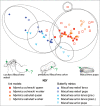Corruption of ant acoustical signals by mimetic social parasites: Maculinea butterflies achieve elevated status in host societies by mimicking the acoustics of queen ants
- PMID: 20585513
- PMCID: PMC2889977
- DOI: 10.4161/cib.3.2.10603
Corruption of ant acoustical signals by mimetic social parasites: Maculinea butterflies achieve elevated status in host societies by mimicking the acoustics of queen ants
Abstract
Recent recordings of the stridulations of Myrmica ants revealed that their queens made distinctive sounds from their workers, although the acoustics of queens and workers, respectively, were the same in different species of Myrmica. Queen recordings induced enhanced protective behavior when played to workers in the one species tested. Larvae and pupae of the butterfly genus Maculinea inhabit Myrmica colonies as social parasites, and both stages generate sounds that mimic those of a Myrmica queen, inducing similar superior treatments from workers as their model. We discuss how initial penetration and acceptance as a colony member is achieved by Maculinea through mimicking the species-specific semio-chemicals of their hosts, and how acoustical mimicry is then employed to elevate the parasite's membership of that society towards the highest attainable level in their host's hierarchy. We postulate that, if acoustics is as well developed a means of communication in certain ants as these studies suggest, then others among an estimated 10,000 species of ant social parasite may supplement their well-known use of chemical and tactile mimicry to trick host ants with mimicry of host acoustical systems.
Keywords: acoustic mimicry; lycaenidae; maculinea; myrmica; phengaris; stridulation.
Figures

Comment on
-
Queen ants make distinctive sounds that are mimicked by a butterfly social parasite.Science. 2009 Feb 6;323(5915):782-5. doi: 10.1126/science.1163583. Science. 2009. PMID: 19197065
Similar articles
-
Variation in butterfly larval acoustics as a strategy to infiltrate and exploit host ant colony resources.PLoS One. 2014 Apr 9;9(4):e94341. doi: 10.1371/journal.pone.0094341. eCollection 2014. PLoS One. 2014. PMID: 24718496 Free PMC article.
-
Acoustical mimicry in a predatory social parasite of ants.J Exp Biol. 2009 Dec;212(Pt 24):4084-90. doi: 10.1242/jeb.032912. J Exp Biol. 2009. PMID: 19946088
-
Queen ants make distinctive sounds that are mimicked by a butterfly social parasite.Science. 2009 Feb 6;323(5915):782-5. doi: 10.1126/science.1163583. Science. 2009. PMID: 19197065
-
The coevolutionary dynamics of obligate ant social parasite systems--between prudence and antagonism.Biol Rev Camb Philos Soc. 2005 May;80(2):251-67. doi: 10.1017/s1464793104006669. Biol Rev Camb Philos Soc. 2005. PMID: 15921051 Review.
-
To b or not to b: a pheromone-binding protein regulates colony social organization in fire ants.Bioessays. 2005 Jan;27(1):91-9. doi: 10.1002/bies.20129. Bioessays. 2005. PMID: 15612031 Review.
Cited by
-
Chemical and behavioral integration of army ant-associated rove beetles - a comparison between specialists and generalists.Front Zool. 2018 Mar 16;15:8. doi: 10.1186/s12983-018-0249-x. eCollection 2018. Front Zool. 2018. PMID: 29568316 Free PMC article.
-
The Inquiline Ant Myrmica karavajevi Uses Both Chemical and Vibroacoustic Deception Mechanisms to Integrate into Its Host Colonies.Biology (Basel). 2021 Jul 12;10(7):654. doi: 10.3390/biology10070654. Biology (Basel). 2021. PMID: 34356510 Free PMC article.
-
A cuckoo-like parasitic moth leads African weaver ant colonies to their ruin.Sci Rep. 2016 Mar 29;6:23778. doi: 10.1038/srep23778. Sci Rep. 2016. PMID: 27021621 Free PMC article.
-
Origin of biomolecular games: deception and molecular evolution.J R Soc Interface. 2018 Sep;15(146):20180429. doi: 10.1098/rsif.2018.0429. J R Soc Interface. 2018. PMID: 30185543 Free PMC article.
-
Variation in butterfly larval acoustics as a strategy to infiltrate and exploit host ant colony resources.PLoS One. 2014 Apr 9;9(4):e94341. doi: 10.1371/journal.pone.0094341. eCollection 2014. PLoS One. 2014. PMID: 24718496 Free PMC article.
References
-
- Elmes GW. Biological diversity of ants and their role in ecosystem function; Lee Kim Sun 96: Proceedings of Inaugural Seminar of KIBIO; 1996; Chonbuk, Korea. pp. 33–48.
-
- Thomas JA, Schönrogge K, Elmes GW. Specialisations and host associations of social parasites of ants. Fellowes Holloway Rolff 05 Insect Evolutionary Ecology, CABI, Wallingford. 2005. pp. 479–518.
-
- Hölldobler B, Wilson EO. The Ants. Berlin,: Springer; 1992.
-
- Nash DR, Boomsma JJ. d’Ettorre Hughes 08 Sociolbiology of Communication. Oxford: Oxford University press,; 2008. Communication between hosts and social parasites; pp. 55–80.
-
- Hughes DP. d’Ettorre Hughes 08 Sociolbiology of Communication. Oxford: Oxford University press,; 2008. The extended phenotype within the colony and how it obscures social communication; pp. 171–190.
LinkOut - more resources
Full Text Sources
